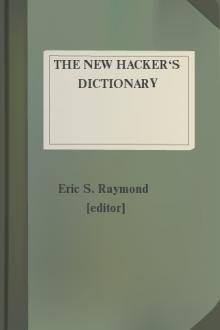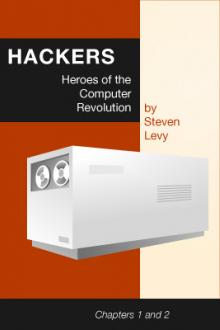The New Hacker's Dictionary by Eric S. Raymond (romantic novels to read .txt) 📕

- Author: Eric S. Raymond
- Performer: 0262680920
Book online «The New Hacker's Dictionary by Eric S. Raymond (romantic novels to read .txt) 📕». Author Eric S. Raymond
the Smithsonian to accept it -- and that the present curator of their
History of American Technology Museum didn't know this and agreed that
it would make a worthwhile exhibit. It was moved to the Smithsonian in
mid-1991, but due to space and money constraints was not actually
exhibited years afterwards. Thus, the process of investigating the
original-computer-bug bug fixed it in an entirely unexpected way, by
making the myth true! --ESR]
Node:bug-compatible, Next:[2087]bug-for-bug compatible,
Previous:[2088]bug, Up:[2089]= B =
bug-compatible adj.
[common] Said of a design or revision that has been badly compromised
by a requirement to be compatible with [2090]fossils or
[2091]misfeatures in other programs or (esp.) previous releases of
itself. "MS-DOS 2.0 used as a path separator to be bug-compatible
with some cretin's choice of / as an option character in 1.0."
Node:bug-for-bug compatible, Next:[2092]bug-of-the-month club,
Previous:[2093]bug-compatible, Up:[2094]= B =
bug-for-bug compatible n.
Same as [2095]bug-compatible, with the additional implication that
much tedious effort went into ensuring that each (known) bug was
replicated.
Node:bug-of-the-month club, Next:[2096]buglix,
Previous:[2097]bug-for-bug compatible, Up:[2098]= B =
bug-of-the-month club n.
[from "book-of-the-month club", a time-honored mail-order-marketing
technique in the U.S.] A mythical club which users of `sendmail(8)'
(the UNIX mail daemon) belong to; this was coined on the Usenet
newsgroup comp.security.unix at a time when sendmail security holes,
which allowed outside [2099]crackers access to the system, were being
uncovered at an alarming rate, forcing sysadmins to update very often.
Also, more completely, `fatal security bug-of-the-month club'. See
also [2100]kernel-of-the-week club.
Node:buglix, Next:[2101]bulletproof, Previous:[2102]bug-of-the-month
club, Up:[2103]= B =
buglix /buhg'liks/ n.
[uncommon] Pejorative term referring to [2104]DEC's ULTRIX operating
system in its earlier severely buggy versions. Still used to describe
ULTRIX, but without nearly so much venom. Compare [2105]AIDX,
[2106]HP-SUX, [2107]Nominal Semidestructor, [2108]Telerat,
[2109]sun-stools.
Node:bulletproof, Next:[2110]bullschildt, Previous:[2111]buglix,
Up:[2112]= B =
bulletproof adj.
Used of an algorithm or implementation considered extremely
[2113]robust; lossage-resistant; capable of correctly recovering from
any imaginable exception condition -- a rare and valued quality.
Implies that the programmer has thought of all possible errors, and
added [2114]code to protect against each one. Thus, in some cases,
this can imply code that is too heavyweight, due to excessive paranoia
on the part of the programmer. Syn. [2115]armor-plated.
Node:bullschildt, Next:[2116]bum, Previous:[2117]bulletproof,
Up:[2118]= B =
bullschildt /bul'shilt/ n.
[comp.lang.c on USENET] A confident, but incorrect, statement about a
programming language. This immortalizes a very bad book about [2119]C,
Herbert Schildt's "C - The Complete Reference". One reviewer commented
"The naive errors in this book would be embarassing even in a
programming assignment turned in by a computer science college
sophomore."
Node:bum, Next:[2120]bump, Previous:[2121]bullschildt, Up:[2122]= B =
bum
vt. To make highly efficient, either in time or space, often at theexpense of clarity. "I managed to bum three more instructions out of
that code." "I spent half the night bumming the interrupt code." In
1996, this term and the practice it describes are semi-obsolete. In
[2123]elder days, John McCarthy (inventor of [2124]LISP) used to
compare some efficiency-obsessed hackers among his students to "ski
bums"; thus, optimization became "program bumming", and eventually
just "bumming". 2. To squeeze out excess; to remove something in order
to improve whatever it was removed from (without changing function;
this distinguishes the process from a [2125]featurectomy). 3. n. A
small change to an algorithm, program, or hardware device to make it
more efficient. "This hardware bum makes the jump instruction faster."
Usage: now uncommon, largely superseded by v. [2126]tune (and n.
[2127]tweak, [2128]hack), though none of these exactly capture sense
All these uses are rare in Commonwealth hackish, because in theparent dialects of English the noun `bum' is a rude synonym for
buttocks' and the verbbum' for buggery.
Node:bump, Next:[2129]burble, Previous:[2130]bum, Up:[2131]= B =
bump vt.
Synonym for increment. Has the same meaning as C's ++ operator. Used
esp. of counter variables, pointers, and index dummies in for, while,
and do-while loops.
Node:burble, Next:[2132]buried treasure, Previous:[2133]bump,
Up:[2134]= B =
burble v.
[from Lewis Carroll's "Jabberwocky"] Like [2135]flame, but connotes
that the source is truly clueless and ineffectual (mere flamers can be
competent). A term of deep contempt. "There's some guy on the phone
burbling about how he got a DISK FULL error and it's all our comm
software's fault." This is mainstream slang in some parts of England.
Node:buried treasure, Next:[2136]burn-in period,
Previous:[2137]burble, Up:[2138]= B =
buried treasure n.
A surprising piece of code found in some program. While usually not
wrong, it tends to vary from [2139]crufty to [2140]bletcherous, and
has lain undiscovered only because it was functionally correct,
however horrible it is. Used sarcastically, because what is found is
anything but treasure. Buried treasure almost always needs to be dug
up and removed. "I just found that the scheduler sorts its queue using
[2141]bubble sort! Buried treasure!"
Node:burn-in period, Next:[2142]burst page, Previous:[2143]buried
treasure, Up:[2144]= B =
burn-in period n.
A factory test designed to catch systems with [2145]marginalcomponents before they get out the door; the theory is that burn-in
will protect customers by outwaiting the steepest part of the
[2146]bathtub curve (see [2147]infant mortality). 2. A period of
indeterminate length in which a person using a computer is so
intensely involved in his project that he forgets basic needs such as
food, drink, sleep, etc. Warning: Excessive burn-in can lead to
burn-out. See [2148]hack mode, [2149]larval stage.
Historical note: the origin of "burn-in" (sense 1) is apparently the
practice of setting a new-model airplane's brakes on fire, then
extinguishing the fire, in order to make them hold better. This was
done on the first version of the U.S. spy-plane, the U-2.
Node:burst page, Next:[2150]busy-wait, Previous:[2151]burn-in period,
Up:[2152]= B =
burst page n.
Syn. [2153]banner, sense 1.
Node:busy-wait, Next:[2154]buzz, Previous:[2155]burst page, Up:[2156]=
B =
busy-wait vi.
Used of human behavior, conveys that the subject is busy waiting for
someone or something, intends to move instantly as soon as it shows
up, and thus cannot do anything else at the moment. "Can't talk now,
I'm busy-waiting till Bill gets off the phone."
Technically, `busy-wait' means to wait on an event by [2157]spinning
through a tight or timed-delay loop that polls for the event on each
pass, as opposed to setting up an interrupt handler and continuing
execution on another part of the task. In applications this is a
wasteful technique, and best avoided on time-sharing systems where a
busy-waiting program may [2158]hog the processor. However, it is often
unavoidable in kernel programming. In the Linux world, kernel
busy-waits are usually referred to as `spinlocks'.
Node:buzz, Next:[2159]BWQ, Previous:[2160]busy-wait, Up:[2161]= B =
buzz vi.
Of a program, to run with no indication of progress and perhapswithout guarantee of ever finishing; esp. said of programs thought to
be executing tight loops of code. A program that is buzzing appears to
be [2162]catatonic, but never gets out of catatonia, while a buzzing
loop may eventually end of its own accord. "The program buzzes for
about 10 seconds trying to sort all the names into order." See
[2163]spin; see also [2164]grovel. 2. [ETA Systems] To test a wire or
printed circuit trace for continuity, esp. by applying an AC rather
than DC signal. Some wire faults will pass DC tests but fail an AC
buzz test. 3. To process an array or list in sequence, doing the same
thing to each element. "This loop buzzes through the tz array looking
for a terminator type."
Node:BWQ, Next:[2165]by hand, Previous:[2166]buzz, Up:[2167]= B =
BWQ /B-W-Q/ n.
[IBM: abbreviation, `Buzz Word Quotient'] The percentage of buzzwords
in a speech or documents. Usually roughly proportional to
[2168]bogosity. See [2169]TLA.
Node:by hand, Next:[2170]byte, Previous:[2171]BWQ, Up:[2172]= B =
by hand adv.
[common] 1. Said of an operation (especially a repetitive, trivial,
and/or tedious one) that ought to be performed automatically by the
computer, but which a hacker instead has to step tediously through.
"My mailer doesn't have a command to include the text of the message
I'm replying to, so I have to do it by hand." This does not
necessarily mean the speaker has to retype a copy of the message; it
might refer to, say, dropping into a subshell from the mailer, making
a copy of one's mailbox file, reading that into an editor, locating
the top and bottom of the message in question, deleting the rest of
the file, inserting `>' characters on each line, writing the file,
leaving the editor, returning to the mailer, reading the file in, and
later remembering to delete the file. Compare [2173]eyeball search. 2.
By extension, writing code which does something in an explicit or
low-level way for which a presupplied library routine ought to have
been available. "This cretinous B-tree library doesn't supply a decent
iterator, so I'm having to walk the trees by hand."
Node:byte, Next:[2174]byte sex, Previous:[2175]by hand, Up:[2176]= B =
byte /bi:t/ n.
[techspeak] A unit of memory or data equal to the amount used to
represent one character; on modern architectures this is usually 8
bits, but may be 9 on 36-bit machines. Some older architectures used
byte' for quantities of 6 or 7 bits, and the PDP-10 supportedbytes'
that were actually bitfields of 1 to 36 bits! These usages are now
obsolete, and even 9-bit bytes have become rare in the general trend
toward power-of-2 word sizes.
Historical note: The term was coined by Werner Buchholz in 1956 during
the early design phase for the IBM Stretch computer; originally it was
described as 1 to 6 bits (typical I/O equipment of the period used
6-bit chunks of information). The move to an 8-bit byte happened in
late 1956, and this size was later adopted and promulgated as a
standard by the System/360. The word was coined by mutating the word
`bite' so it would not be accidentally misspelled as [2177]bit. See
also [2178]nybble.
Node:byte sex, Next:[2179]bytesexual, Previous:[2180]byte, Up:[2181]=
B =
byte sex n.
[common] The byte sex of hardware is [2182]big-endian or
[2183]little-endian; see those entries.
Node:bytesexual, Next:[2184]Bzzzt! Wrong., Previous:[2185]byte sex,
Up:[2186]= B =
bytesexual /bi:t`sek'shu-*l/ adj.
[rare] Said of hardware, denotes willingness to compute or pass data
in either [2187]big-endian or [2188]little-endian format (depending,
presumably, on a [2189]mode bit somewhere). See also [2190]NUXI
problem.
Node:Bzzzt! Wrong., Next:[2191]C, Previous:[2192]bytesexual,
Up:[2193]= B =
Bzzzt! Wrong. /bzt rong/ excl.
[common; Usenet/Internet; punctuation varies] From a Robin Williams
routine in the movie "Dead Poets Society" spoofing radio or TV quiz
programs, such as Truth or Consequences, where an incorrect answer
earns one a blast from the buzzer and condolences from the
interlocutor. A way of expressing mock-rude disagreement, usually
immediately following an included quote from another poster. The less
abbreviated "Bzzzzt, wrong, but thank you for playing" is also
common; capitalization and emphasis of the buzzer sound varies.
Node:= C =, Next:[2194]= D =, Previous:[2195]= B =, Up:[2196]The
Jargon Lexicon
= C =
[2197]C:
[2198]C Programmer's Disease:
[2199]C&C:
[2200]C++:
[2201]calculator:
[2202]Camel Book:
[2203]can:
[2204]can't happen:
[2205]cancelbot:
[2206]Cancelmoose[tm]:
[2207]candygrammar:
[2208]canonical:
[2209]card walloper:
[2210]careware:
[2211]cargo cult programming:
[2212]cascade:
[2213]case and paste:
[2214]casters-up mode:
[2215]casting the runes:
[2216]cat:
[2217]catatonic:
[2218]cathedral:
[2219]cd tilde:
[2220]CDA:
[2221]cdr:
[2222]chad:
[2223]chad box:
[2224]chain:
[2225]channel:
[2226]channel hopping:
[2227]channel op:
[2228]chanop:
[2229]char:
[2230]charityware:
[2231]chase pointers:
[2232]chawmp:
[2233]check:
[2234]cheerfully:
[2235]chemist:
[2236]Chernobyl chicken:
[2237]Chernobyl packet:
[2238]chicken head:
[2239]chiclet keyboard:
[2240]Chinese Army technique:
[2241]choad:
[2242]choke:
[2243]chomp:
[2244]chomper:
[2245]CHOP:
[2246]Christmas tree:
[2247]Christmas tree packet:
[2248]chrome:
[2249]chug:
[2250]Church of the SubGenius:
[2251]Cinderella Book:
[2252]CI$:
[2253]Classic C:
[2254]clean:
[2255]CLM:
[2256]clobber:
[2257]clock:
[2258]clocks:
[2259]clone:
[2260]clone-and-hack coding:
[2261]clover key:
[2262]clue-by-four:
[2263]clustergeeking:
[2264]co-lo:
[2265]code:
[2266]coaster:





Comments (0)